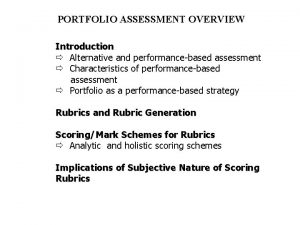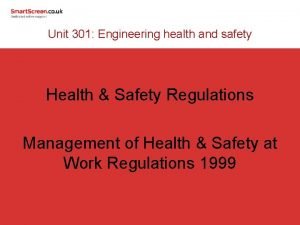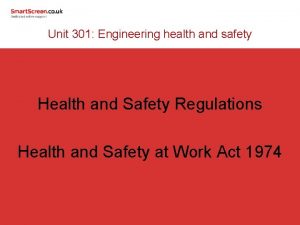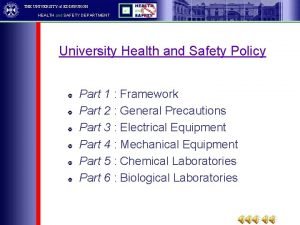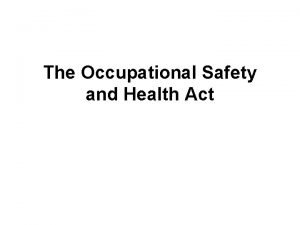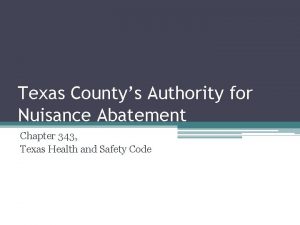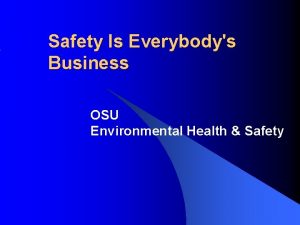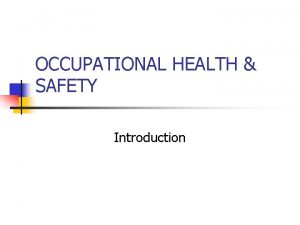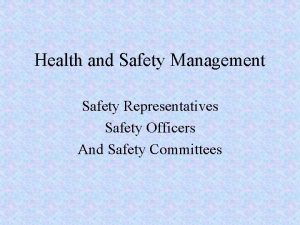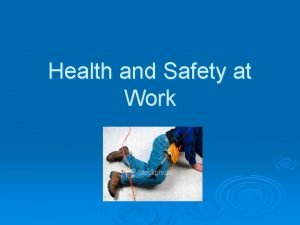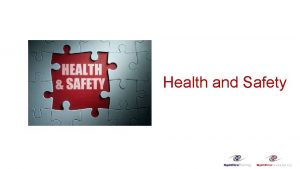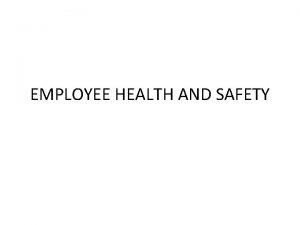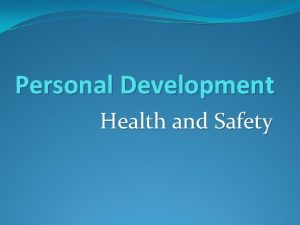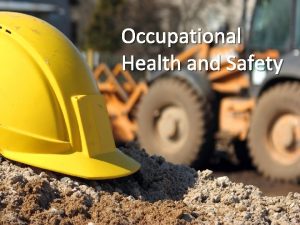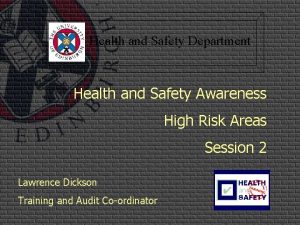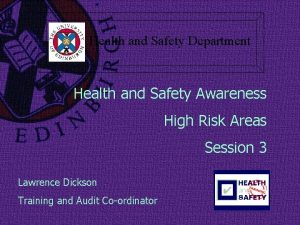Introduction to Safety and Health Preface and Chapter





























- Slides: 29

Introduction to Safety and Health Preface and Chapter. 1 (Goetsch)

Safety vs Health • Safety and healthough closely related are not the same. • One view is that – Safety is concerned with injury-causing situations, whereas health is concerned with disease causing situations. – Another view is that safety is concerned with hazards to humans that result from sudden severe conditions; health deals with adverse reactions to prolonged exposure to dangerous but less intense hazards. • An acute effect is a sudden reaction to a severe condition, while a chronic effect is a long-term deterioration due to a prolonged exposure to a milder adverse condition (Asfahl).

Safety vs Health • Both concepts are accurate in portraying safety and health issues. However, there is no clear line between the two concepts. – For example, stress is a hazard can cause both p_____ and p_____ problems over a prolonged period. So, it is a ____concern. On the other hand, an overly stressed worker may be prone to accidents generating a _____concern.

Safety vs Health – Long term exposure to noise levels in the range of 90 -100 decibels causes permanent damage. _____ – A sudden acute exposure to impact noise can injure the hearing system. ______ (Asfahl) – Let’s come up with a similar example or two

Safety and Health Movement, Then and Now • The safety area in the US has developed steadily since early 1900 s. • In the early 1900 s, industrial accidents were common. – In 1907 over 3200 people were killed in mining accidents. – Then, legislation and public opinion all favored management. . – There were a few protections for workers’ safety.

Safety and Health Movement, Then and Now • Working conditions for industrial employees have improved significantly. – Chance of a worker being killed is less than half of what it was 60 years ago. – According to the NSC ________, the current death rate from work-related injuries is approx. 4 per 100, 000 or less than a third of the rate 50 years ago.

Safety and Health Movement, Then and Now • Improvements have been the result of: – The pressure for legislature to promote safety and health, – The steadily increasing costs associated with accidents and injuries, • The future improvements will be driven by cost effectiveness and resultant competitiveness gained from a safe and healthy workplace. – The professionalization of safety as an occupation.

Development Before the Industrial Revolution • Code of Hammurabi contained clauses pertaining to safety and health. – “If a man has caused the loss of a gentlemen’s eye, his own eye shall be caused to be lost”. • Egyptians used slaves in building temples and pyramids. – Rameses II to ensure the maintenance of a workforce sufficient to build his major project, created an industrial medical service and required each worker to bathe daily.

Development Before the Industrial Revolution • The Romans were very concerned about safety and health. – __________________ • In the 16 th Century, Philippus Aureolus looked at pulmonary disease of miners/diseases of smelter workers/metallurgists and Georgius Agricola emphasized the need for ventilation systems in the mines.

Development Before the Industrial Revolution • In the 18 th Century, Bernardino Ramazzini drew parallels between diseases suffered by workers and their occupations. – Handling of harmful materials, irregular or unnatural movements of the body • The Industrial Revolution change the nature of production: – – Introduction of inanimate power Substitution of machines for people Introduction of new methods in fabrication Organization and specialization of work

Milestones in the Safety Movement • The safety movement traces its roots to England. • Industrial Revolution – Outbreak of fever among the children working in cotton mills led people in Manchester demand better working conditions in the factories. – In 1802 the Health of Morals of Apprentices Act was passed.

Milestones in the Safety Movement • When the industrial sector began to grow in the US, hazardous working conditions became common. – Following the Civil War, the seeds of the safety movement were sown. • • Factory Inspection – 1867 in MA. First barrier safeguard patent – 1868 PA legislature mine safety law – 1869 Bureau of Labor Statistics established - 1869

Milestones in the Safety Movement – MA legislature passed a law requiring safeguards for hazardous machinery – 1877 – Employer’s liability law – 1877 – First recorded safety program established in IL – 1892 – Frederick Taylor conducts first systematic study on efficiency in manufacturing – 1900 – Bureau of Mines created – 1907 – Concept of Workers Compensation introduced – 1908 • WI passed the first effective law on WC

Milestones in the Safety Movement – First cooperative study congress in Milwaukee - 1912 – National Council of Industrial Safety formed – 1913 – NCIS changed name to National Safety Council – 1915 – Concept of negligent manufacturer established - 1916

Milestones in the Safety Movement – National Silicosis Conference organized by US Secretary of Labor – 1936 – Relation between quality and safety and job accidents have negative effect on productivity – OSH act passed – 1970 – Federal Mine Safety Act passes – 1977 – Superfund Amendments and Reauthorization passes – 1986 – Amended Clean Air Act of 1970 passes

Milestones in the Safety Movement – Total Safety Management concept introduced – 1996 – US firms begin to pursue ISO 14000 registration for ESM__________ 2000 – Workplace terrorism is an ongoing concern of safety and health professionals - 2003

Tragedies That Have Changed the Safety Movement • Hawk’s Nest Tragedy • Asbestos Menace • Bhopal Tragedy

Role of • Organized Labor – Seeked safe and healthy work environments – Some say they focused too much on wages and benefits – Overturn the antilabor laws relating to safety • Fellow Servant Rule (in still NH) /Contributory Negligence • Assumption Risk • Specific Safety and Health Problems – Lung Disease in Miners • Anthrocosis / Black Spit • Coal Workers Pneumonoconosis • Gauley Bridge Disaster – Explosion in a mine in WV in 1968

Role of – Mercury Poisoning in 1930 s Japan due to release of methyl mercury into the sea • Mercury nitrate was used in hat-making in the US – Asbestos exposure • Asbestosis or (Mesothelioma) Cancer

Development of Accident Prevention Programs – Will be covered with the Accident related chapters.

Safety and Health Movement Today • Came a long way from Industrial Revolution ways. • Tone was set during the WWII. – Need for various specialists arose: safety engineers, safety managers, industrial hygienists, occupational health nurses, and physicians.

Safety and Health Movement Today • H. G. Dyktor proposed the following objectives of integration (cooperation): – Learn more through sharing knowledge about health problems in the workplace, particularly those caused by toxic substances – Provide a greater level of expertise in evaluating health and safety problems. – Provide a broad database that can be used to compare health and safety problems experienced by different companies in the same industry. – Encourage accident prevention – Make employee health and safety a high priority

Integrated Approach to Safety and Health • By working together and drawing on their areas of expertise, S & H professionals are better able to identify, predict, control, and correct S & H problems. • OSHA reinforces this integrated approach by requiring companies to have a plan for doing: – Providing appropriate medical treatment for injured or ill workers – Regularly examining workers who are exposed to toxic substances – Having qualified first-aid person available during all work hours

Integrated Approach to Safety and Health • Small companies may contract, while the large ones have their own staff: – Industrial Hygiene Chemist and/or Engineer • Periodically test the work environment and the workers • Dust levels, ventilation, and noise levels. . – Radiation Control Specialist • Electrical Engineer and Physicist • Test radiation levels • Prepare plans for accidents/decontamination procedures – Industrial Safety Manager or Engineer • Developing Programs – Other

Development of Safety Organizations • Alliance for American Insurers • American Board of Industrial Hygiene • American Conference of Government Industrial Hygienists • American Industrial Hygiene Association • American Insurance Association • American National Standards Institute • American Occupational Medical Association • American Society of Testing and Materials • American Society of Mechanical Engineers

Development of Safety Organizations • • Chemical Transportation Emergency Center Human Factors Society National Fire Protection Association National Safety Council National Safety Management Society of Automotive Engineers System Safety Society Underwriter’s Laboratories

Government Organizations • • • Bureau of Labor Statistics Bureau of National Affairs Environmental Protection Agency National Institute for Standards and Technology National Institute for Occupational Safety and Health • Occupational Safety and Health Administration • Superintendent of Documents, US Government Printing Office • US Consumer Product Safety Commission

Other Organizations • American Public Health Association • Commerce Clearing House

New • Materials, Processes, and New Problems
 Preface to the fables
Preface to the fables Chapter 16: employee safety and health
Chapter 16: employee safety and health Thesis defense introduction script
Thesis defense introduction script Preface of dorian gray
Preface of dorian gray Miss julie as a naturalistic tragedy
Miss julie as a naturalistic tragedy Thank you for listening harry potter
Thank you for listening harry potter Preface of a book example
Preface of a book example Preface from behind the scenes
Preface from behind the scenes Preface
Preface Unced
Unced Example of portfolio assessment plan
Example of portfolio assessment plan Chapter 3 health wellness and health disparities
Chapter 3 health wellness and health disparities Chapter 1 lesson 2 what affects your health
Chapter 1 lesson 2 what affects your health Chapter 1 understanding your health and wellness
Chapter 1 understanding your health and wellness Health care agencies introduction
Health care agencies introduction Which display mode is allowed for proper navigation?
Which display mode is allowed for proper navigation? Safety care certification
Safety care certification Process safety vs personal safety
Process safety vs personal safety Safety assessment for ind safety reporting
Safety assessment for ind safety reporting Basic safety (construction site safety orientation)
Basic safety (construction site safety orientation) Basic safety orientation
Basic safety orientation 4 cs health and safety
4 cs health and safety Health and safety at work act engineering
Health and safety at work act engineering Safety and health edinburgh
Safety and health edinburgh Williams-steiger occupational safety and health act of 1970
Williams-steiger occupational safety and health act of 1970 Care certificate answers standard 3
Care certificate answers standard 3 Texas health and safety code 343
Texas health and safety code 343 Six pack health and safety regulations
Six pack health and safety regulations Kpi health and safety
Kpi health and safety Osu ehs training
Osu ehs training










